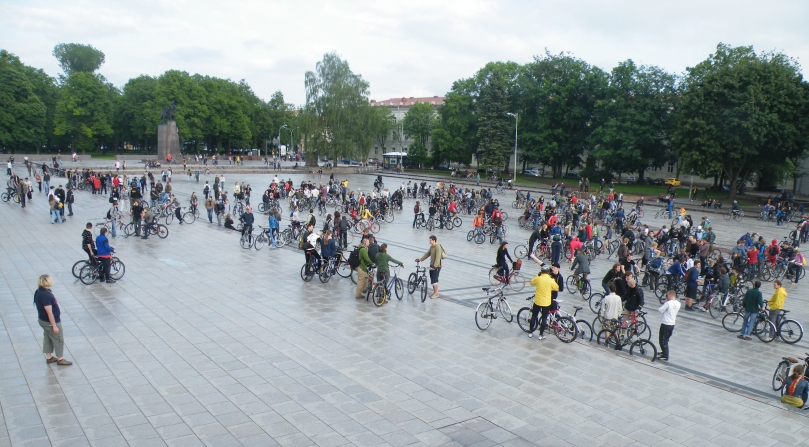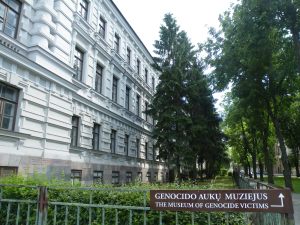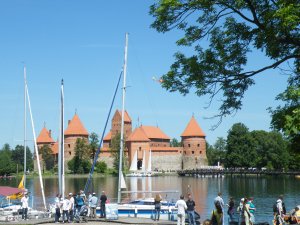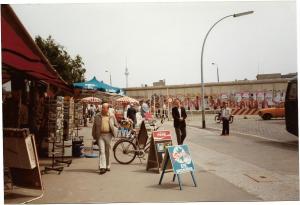We visited Vilnius, capital of Lithuania and our last and favourite of the three Baltic capitals, in May 2010. I originally booking a direct flight with Aer Lingus, who then re-considered this route and cancelled the flights. There were then no direct flights from London, so we flew with SAS from Heathrow to Copenhagen, hung around for a couple of hours (thankfully Copenhagen is a lovely airport in which to spend time) and then flew to Vilnius. We were able to use Airmiles which sweetened the 10 hour process (including check in and time changes) and there was another less obvious benefit in visiting a European capital city which doesn’t have direct flights from England: no stag parties!
We liked Vilnius a lot: apart from the lack of drunken stag parties, it is a very green city with lots of trees, parks and public gardens – apparently green spaces cover over 46% of the city. There are also many pretty churches in Vilnius which survived Soviet occupation; elderly ladies in national dress played music in the Cathedral Square and Vilnius lacks the dour feeling which can permeate some of the former Soviet cities and also lacks too many concrete Stalinist public buildings.
Vilnius felt modern and free-thinking in the way Amsterdam can feel and its locals shared with the Dutch a love of bicycles. We observed – with no explanation that we could think of – a huge gathering of cyclists, mostly young, one late afternoon/early evening, cycling round and round in the Cathedral Square. Was this a silent protest? Was this a silent cycle rally (like a silent disco?) or was it a way young people met in Vilnius? We’ll probably never know.

Another quirky area in Vilnius was the Uzupis Republic, an artist’s district located on a bend of the river Vilnele which was like the artist’s district in Dresden which we visited a few years later. Uzupis seemed to us a 20th Century hippy space but we learnt it has been the creative centre of Vilnius for centuries and the residents take part in the annual Montmartre Fair in Paris. It is home to many art galleries and workshops as well as places to eat and drink and the residents are guarded by an angel in one of the squares and there is also a mermaid to be seen on the river bank. The Republic is also home to the smallest church in Vilnius, the church of St Bartholomew.
In Vilnius we stayed at the Artis Centrum Hotel chosen, as usual, for it’s central location (the clue is in the name) where we paid 240 euros for 3 nights bed and breakfast. The city is compact and we could walk to everywhere we wanted to see, starting off – as we often do – with a hop on hop off bus tour to give us an overview.
One of the places where we hopped-off was the former KGB headquarters and what a chilling place that is. It is unnerving partly because of its appearance and location as it bears a distinct resemblance to a department store on Oxford Street, not hidden away in a back street as we would have imagined. It had originally been a prison, and was then used by the Gestapo during WW2 and after the war when Lithuania became part of the USSR the KGB took advantage of the ready-built cells and torture chambers. When we visited it was called the Museum of Genocide Victims (now renamed the Museum of Occupations and Freedom Fighters) and has been left as it was, as if the former inhabitants had left just before we arrived. There were padded cells and cells too small to sit down or stretch out in, and one which had a small central concrete circle surrounded by a “moat”. We read that a prisoner would have to stand on the concrete circle and when s/he fell with exhaustion s/he would fall into what would be icy water and have to climb out and back onto the concrete stand, now in wet clothes in the bitter Lithuanian winter.

There were photos of some of the people who were known to have gone through the building and those known to go in but not return, as well as statistics and photos of the very many Lithuanians who were deported to Gulags in the Soviet Bloc. There were areas with bullet holes in the wall or blood stains. There was only one other visitor while we were there which made it especially chilling, to walk around the dark and damp underground areas more on less on our own, knowing that above ground only a few yards away people were shopping and socialising and definitely not wanting to relive the grim days in their recent history.
We took a day trip out of Vilnius and visited the old town of Trakai, one of the former capitals of Lithuania and a place very popular with tourists and locals alike. It is a town formerly of much historical importance but now visited for the Castle which is situated in a lake, and reached by a bridge. It’s a very pretty setting and we had lovely sunny weather but apart from that, we found it rather dull (my husband expressed this more strongly in his holiday diary….)

The only thing I could mark Vilnius down on was the local food, which was far too bland for my palate – based on root vegetables and pork in common with most northern European countries; I felt everything I tasted needed Tabasco, Worcestershire sauce or even a good twist of black pepper….
We paid £164.22 in cash in addition to our airmiles for the flights and the Hotel Artis Centrum was £202.79 for 3 nights bed and breakfast. We spent an additional £437.15 on food, drinks and transport, so £804.16 in total for the trip.














